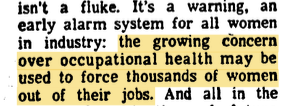Women in the Workplace
We have blogged previously about the toxic effects of lead on working class women. In the early 20th century, early scientific evidence began to show that women exposed to lead were more likely to have complications in their pregnancies.
The document we are highlighting today is an article by Ellen Goodman in the Cleveland Plain Dealer from June 20, 1976. The 1970s were a heyday for environmental and occupational health regulation. This report focuses on womens’ reactions to the new policies that claimed to be for their benefit.
It opens with a story about single mother Norma James, who chose to be sterilized so she would not be forced to leave her job. The General Motors factory where she worked contained lead oxide, a compound which could harm fetuses, and so the company instituted a policy that fertile women had to be transferred. The article took this event to serve as a rallying cry to other women in the workplace:
Goodman did not just take aim at General Moters. She also took aim at the gendered nature of scientific studies that focused on women. Most toxic substances that harmed ova also harmed sperm, after all. Ultimately, she viewed the gendered policies set by companies not as humanitarian, but as selfish and myopic. Goodman concluded they missed the bigger picture:
“When industry excludes fertile women, they avoid the larger issue of safety in the work place. It's cheaper to get rid of them than to get rid of the danger.”

